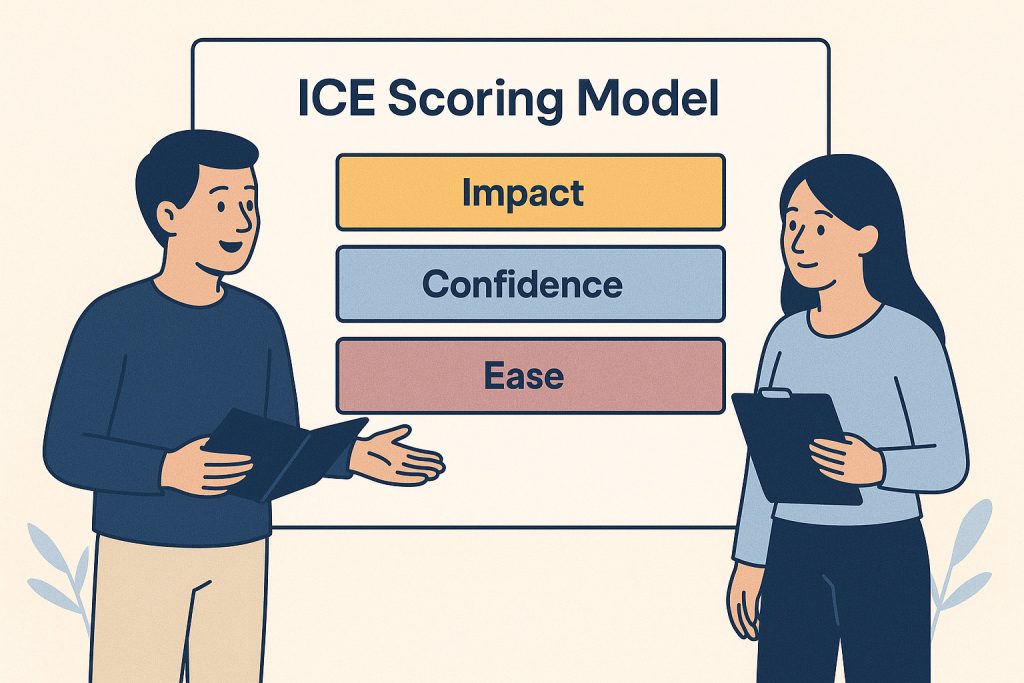The ICE Scoring Model serves as an efficient framework for evaluating and ranking potential initiatives by assigning quantitative values across three critical dimensions: Impact, Confidence, and Ease of implementation.
What is the ICE Scoring Model?
ICE Scoring represents one of several strategic approaches available for determining feature priorities within product development cycles. The methodology operates by evaluating each proposed initiative against three core criteria—Impact, Confidence, and Ease—with scores ranging from one to ten for each dimension. These individual scores are then multiplied together to produce a composite ICE Score that enables direct comparison between different options.
Impact measures the anticipated effect on primary business objectives or key performance indicators. Confidence reflects the degree of certainty regarding whether the initiative will deliver its expected outcomes. Ease assesses the resources, time, and complexity required for successful execution.
Consider two competing proposals: Project Alpha receives scores of eight for Impact, seven for Confidence, and four for Ease, yielding an ICE Score of 224. Project Beta scores six for Impact, nine for Confidence, and eight for Ease, producing an ICE Score of 432. Despite Project Alpha’s higher impact potential, Project Beta emerges as the preferred choice due to its superior overall score, primarily driven by greater implementation feasibility and outcome certainty.
This mathematical approach ensures that no single factor dominates the decision-making process, as each component carries equal weight in the final calculation, distinguishing it from weighted scoring methodologies that might emphasize certain criteria over others.
Why is ICE Scoring Useful and Who Created it?
Among various prioritization frameworks, ICE distinguishes itself through its streamlined approach and rapid application capability. The model’s efficiency stems from requiring only three data points per evaluated item, enabling teams to quickly process large volumes of potential initiatives and establish clear priority rankings.
The framework offers greater simplicity compared to the RICE model, which incorporates Reach as an additional variable and substitutes Effort for Ease, resulting in the formula: Reach × Impact × Confidence ÷ Effort. This added complexity, while potentially more comprehensive, can slow down the evaluation process.
Sean Ellis, renowned for popularizing the concept of “growth hacking,” developed the ICE framework to support rapid experimentation cycles. Ellis recognized that growth-focused teams needed a prioritization tool that matched their fast-paced, iterative approach to testing and optimization. The model’s emphasis on speed aligns perfectly with growth hacking principles of quick hypothesis testing and rapid iteration.
However, the model’s simplicity comes with inherent limitations. ICE scoring functions as an approximation tool rather than a rigorous analytical framework, making it less suitable for complex, high-stakes decisions. The subjective nature of scoring introduces significant variability, as different evaluators may assign vastly different ratings to identical initiatives based on their perspectives and experiences.
The equal weighting of all three factors can create situations where a single low score dramatically reduces an initiative’s overall ranking. This characteristic reflects the model’s experimental origins, where “failing fast” provides valuable learning opportunities, and teams prefer to avoid lengthy commitments to uncertain outcomes. However, this approach may inadvertently discourage investment in high-impact initiatives that require substantial resources or extended timelines.
ICE Scoring performs optimally in comparative scenarios involving a limited set of alternatives, helping teams identify the most promising option among several candidates. When applied to comprehensive backlogs, it effectively surfaces top-tier opportunities aligned with current strategic objectives.
A significant limitation involves the knowledge requirements for accurate scoring. Impact and Confidence assessments demand business acumen and market understanding, while Ease evaluation requires technical expertise and development experience. Few individuals possess comprehensive knowledge across all these domains, potentially compromising scoring accuracy.
Organizations can address this challenge by involving development teams in Ease assessments, leveraging their technical expertise while allowing business stakeholders to focus on Impact and Confidence evaluations. However, this collaborative approach may conflict with ICE Scoring’s intended speed advantage, particularly when evaluating numerous potential initiatives.
Establishing consistent scoring criteria becomes crucial for maintaining evaluation integrity. Without clear definitions for each rating level across all three dimensions, team members may interpret scores differently, leading to inconsistent assessments and unreliable comparisons.
While ICE Scoring offers valuable benefits for specific use cases, it may not provide sufficient depth for comprehensive product roadmap planning. The model works best for preliminary filtering, opportunistic decision-making, or situations requiring rapid consensus-building around limited options.
Conclusion
ICE Scoring’s primary advantages lie in its accessibility and implementation speed, making it an effective tool for initial prioritization exercises and quick decision-making scenarios. However, these strengths also represent potential weaknesses, as the model evaluates initiatives against single objectives rather than considering multiple concurrent organizational goals, limiting its effectiveness in complex strategic environments.
Despite lacking the sophistication of more comprehensive frameworks, ICE Scoring provides valuable utility for narrowing options and establishing comparative baselines for decision-makers. In consensus-building situations, the ability to systematically eliminate less promising alternatives can prove as valuable as identifying optimal choices.
The model’s effectiveness ultimately depends on appropriate application—using it as a rapid filtering mechanism rather than a comprehensive strategic planning tool maximizes its benefits while minimizing its limitations.


